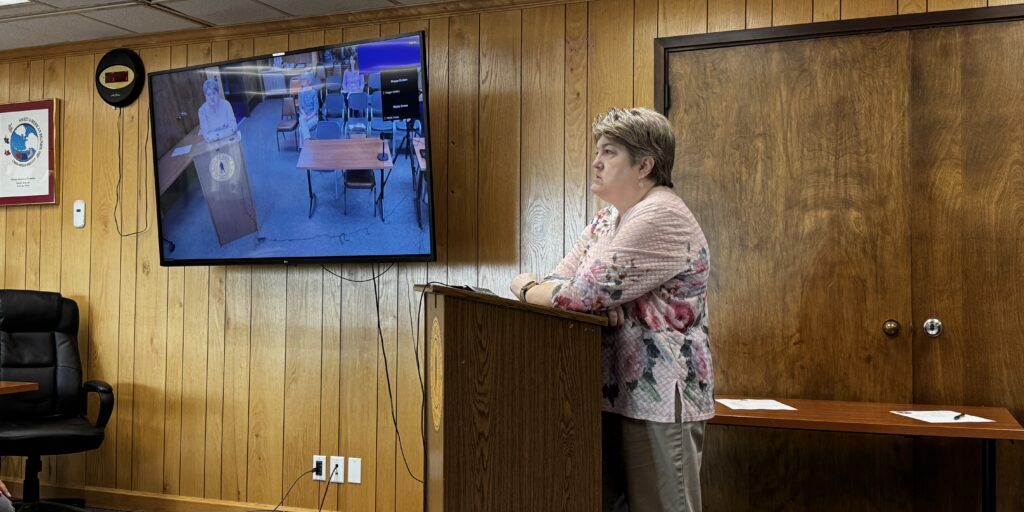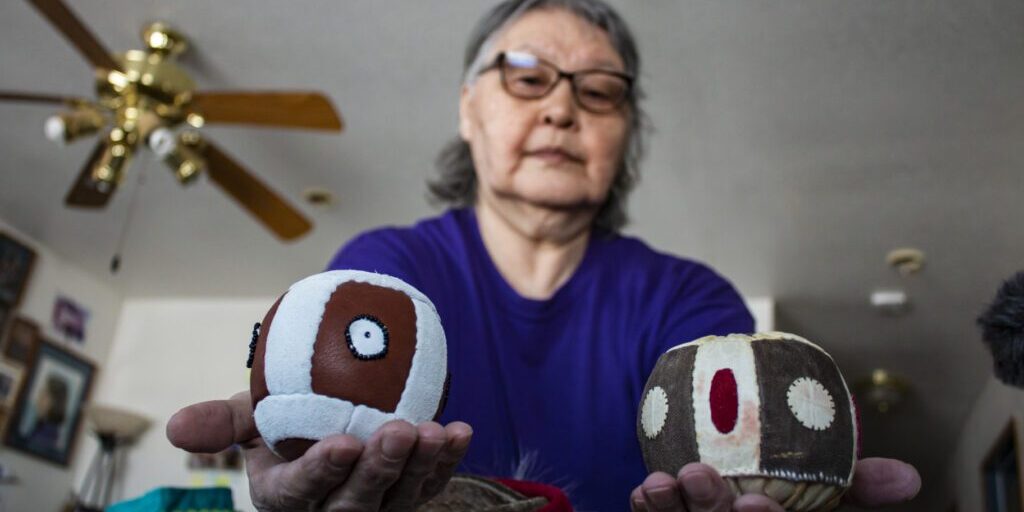A new curriculum from a St. Lawrence Island artist and educator seeks to reintroduce the art of dried skin sewing into Alaskan schools. Published by Lydia Apatiki of Gambell, with support from Kawerak Inc., “Sivuqam Kelugwi: A St. Lawrence Island Traditional Sewing Curriculum” uses a symbiosis of technology and traditional knowledge to revitalize a forgotten art.
Last month, KNOM visited with Lydia and her family in Gambell to learn about the curriculum and listen to her story.
Two hundred miles from Nome in the western Bering Sea, Gambell is located on the northwestern tip of St. Lawrence Island.
The Alaska Native community of roughly seven hundred sits below a range of bluffs and is surrounded by beaches on three sides. In late spring, as the ice begins to break, Gambell’s hunters travel miles from their rocky shores to hunt walrus and bowhead whale.
Lydia Apatiki was born and raised on the island. The youngest daughter of Thomas and Pauline Apassingok, she grew up watching her mother and aunt scrub walrus skins and labor over bird skin parkas.
“As I was growing up, I seen ladies sewing; repairing hunting clothing and they make boats for us children. I [saw] my adoptive mother sew all the time. Whenever she had something to sew, she would complete a project that she needs to finish, like boots or intricate sewing.”
– Lydia Apatiki
The art of skin sewing has long been a treasured skillset in Western Alaska, especially in Central and Siberian Yupik communities, like Gambell and Savoonga. Possessing a depth of knowledge as well as patience and physical prowess, local artisans were responsible for building umiaks (walrus skin boats) and atkuks (bird skin parkas). Typically, the boats lasted three to four years and were critical hunting tools.
Bird skin parkas were traditionally worn by male hunters. Light and warm, an atkuk is sewn in such a way that it is reversible. This is accomplished by means of a complicated stitching method using nemeq, or whip stitch. If the inside of a hunter’s bird skin parka got wet, he could turn it inside out and, in subzero temperatures, it would freeze-dry instantly. Meanwhile the hunter would stay warm with a dry parka against his skin.
These sewing projects took weeks to complete and the craftswomen of Gambell who made them were well-respected. Umiak frames—upon which the traditional boats were constructed—still dot the village beaches today.
Lydia’s husband, Jerome Apatiki, has spent decades hunting walrus during the ice breakup. As a young captain, he used an umiak to subsist on the open water miles away from St. Lawrence Island.
“Without the skin boat, we wouldn’t go out that way. The hardest part of the work is at home. First of all, our ladies split [the walrus hide] …… Oh they are perfect doing it. Real, real good. We dry them [the hides] for a couple weeks or so, and then we change the old skin they are wearing that was put on the frame of the boat. It’s lots of work, I wish you [could] watch us do that.”
– Jerome Apatiki

Jerome Apatiki is an elder now, but he still hunts every season when the weather cooperates. His boat, however, is no longer traditionally constructed.
“Technology came along. We’re using aluminum boats now. We miss the boats sometimes because they can travel more easily on rough seas.”
They’re this thick, Apatiki says, pinching his thumb and index finger together, but strong.
Lydia Apatiki and her husband Jerome grew up together in Gambell. Jerome got to know his future in-laws through a traditional courtship process.
Jerome: I worked for her for two years. My wife. At their home.
Lydia: Yeah hauling water, and hunting for my parents.
Jerome: My family came by with all kinds of things. Even with a big skin of walrus to cover the boat.
In the evenings the two would walk along the island’s western beaches, Russian mountains barely visible in the sea-mist.
Young people in the village would often spend their free time on the beach, playing with an aangqaq—or game ball—and singing. Decades later, Lydia Apatiki still remembers her childhood songs.
A Meat Ball Song
| FY 16 | FY 15 | |
|---|---|---|
| newsletter | $135,005 | $116,529 |
| administrative | $64,238 | $57,714 |
| mission operations | $228,391 | $209,857 |
| staff | $667,193 | $721,677 |
| fundraising | $325,548 | $379,595 |
| volunteer time (net) | $90,232 | $150,899 |
| in-kind travel | $49,343 | $14,740 |
| total | $1,559,950 | $1,651,011 |
A traditional game ball song from Gambell. From “Sivuqam Kelugwi.”
Hover over the text to see an english translation of the Siberian Yupik.

In the 1970s, Lydia Apatiki started working at Gambell’s elementary school as a bilingual aide. The school’s curriculum leaned on the students to learn English, but Apatiki worked hard to incorporate Siberian Yupik into her everyday lesson plans. She remembered watching her mother with a needle in her hand, bent over dried walrus skin. Apatiki decided it was time to learn.
“I got motivated while teaching in the school to complete a bird skin parka.”
Her students had only ever seen a bird skin parka in books or behind glass in a museum. They had never smelled one. They had never felt its warmth.
And for Apatiki, she had never sewn an atkuk before. She asked her husband Jerome to head to the bluffs east of town and gather common murres and parakeet auklets for her. Then Apatiki went to her family for advice.
“And my aunt, who’s passed now. I’m so appreciative to her, who taught me how to put together a bird skin parka. As I was sewing it was so hard to do. I told her, maybe I should quit. She scolded me. She said: ‘you started this, and you must finish it.”
And so, she did. Apatiki’s son Joshua wore the parka to school the next day. It was a tawny gray, highlighted by two bright spots of white across its breast, made out of two types of birds. Years later her son has grown tall and that parka no longer fits, but the knowledge of how it was put together still remains.

Speaking to Kawerak earlier this year, veteran researcher and writer Patricia Partnow elaborated on Apatiki’s gift to her culture: “Most coastal people in Alaska made parkas out of bird skins, and there are many examples in museums, but Lydia is the only person I know who has made one herself using the knowledge from her elders….What a loss if we had not been able to record this bit of human knowledge.”
Today, there are strict subsistence regulations regarding the harvesting of auklets and murres, according to the National Marine Fisheries Service. However, anyone can learn how to sew a bird skin parka. Apatiki, with the support of entities like Kawerak and the CIRI Foundation, has published an online and print curriculum to revitalize the art.
The curriculum is called: “Sivuqam Kelugwi,” which means St. Lawrence Island sewing in Siberian Yupik. On its webpage, visitors can learn how to sew the bird skin parka, as well as a game ball (aangqaq ), and taghnughhaghwaaq, a St. Lawrence traditional cloth doll made from reindeer skin.
Funding for the site was made possible through support from First People’s Fund, a nonprofit foundation headquartered in Rapid City, SD. The Fund focuses on business development, including specialized training for native artists.
Alice Bioff is the Business Planning Specialist at Kawerak Inc. in Nome. Several years ago, she attended a workshop hosted by First People’s Fund, and was impressed.
“What made the curriculum absolutely unique was that it incorporated the discussion of our indigenous culture, which was amazing I’d never seen anything like that. And since then, Kawerak has been partnering with First People’s Fund.”
– Alice Bioff
Three years ago, Apataki applied for a grant through Kawerak’s partnership with the Fund.
“It was amazing and humbling to work with Lydia. She’s just amazing. The passion she has to keep moving forward with this project. This took about three years for her to go from the idea to then having the website go live. Thankful to all the partners and supporters but Lydia was the driving force. She had a vision. She thought that the website would be the best way to get the product out there to share.”
The website is sleek and modern, interspersed with photos of the finished products, aspiring traditional sewers can browse through patterns or watch videos of Apatiki practicing the craft. Carol Gales, a Nome-based graphic designer, devised the sewing diagrams for the curriculum. In order to accurately design the patterns, she worked with Apatiki in-person.

“Alice [Bioff] found funding to send me out to Gambell for a few days and they were very intense few days of sewing. I would go over to Lydia’s house and we would sit down, and we would go through everything. I brought some fabric scraps and my sewing supplies and sat down in the kitchen and we basically, we went through each step.”
– Carol Gales
After working side-by-side with Apatiki, Gales learned to sew both the aangqaq (game ball) and the taghnughhaghwaaq (St. Lawrence Island cloth doll).
“I still have my prototype doll staring at me from my bookshelf.”
Apatiki’s goals for “Sivuqam Kelugwi” are similar to the ones she had back when she was an educator in the 1970s. She sees the traditional art as one of many paths for reclaiming her native culture.
“The book I made is for our children. We have limited books on our language. Hopefully this book will spark interest in some of our children to continue on. It is very important to keep in mind where you come from and who you are.”
– Lydia Apataki
While “Sivuqam Kelugwi” is available for purchase online, Apatiki has made it a priority for the entire curriculum to be free to educational institutions. In her words, funding will never be a barrier for students to connect with their culture.
Bioff, whose job focuses on promoting economic independence in small businesses, adds that sometimes it’s about more than just the money.
“You know, there’s definitely that business development [aspect]… supporting our local economies. But also tied into that landscape—that ecology—is the importance of the local art and how tied in it is with preserving our way of speaking and doing. It’s all interconnected. That’s what we’ve learned through this process, and through working with Lydia and Jerome.”
Image at top: Lydia Apatiki holds up two aangqaqs. One made from traditional materials, the other from industrial leather. Photo from JoJo Phillips, KNOM (2020).




